Ecological Design and Construction Strategies through Life Cycle Assessment of Carbon Budget for Urban Parks in Korea
Abstract
1. Introduction
Related Research
2. Materials and Methods
2.1. Selection of Study Parks
2.2. Goal and Scope Definition
2.3. Data Collection and Analysis
2.3.1. Vegetation Production
2.3.2. Paving Materials Production
2.3.3. Transport
2.3.4. Construction
2.3.5. Tree Growth
2.3.6. Management
2.3.7. Demolition and Disposal
2.4. Estimation of Carbon Budget
3. Results and Discussion
3.1. Land Cover Types and Tree Planting Structures
3.2. Life Cycle Assessment of Carbon Budget
3.2.1. Vegetation and Paving Materials Production
3.2.2. Transport
3.2.3. Construction
3.2.4. Vegetation Growth
3.2.5. Management
3.2.6. Demolition and Disposal
3.2.7. Carbon Budget
3.3. Ecological Design and Construction Strategies
4. Conclusions
Author Contributions
Funding
Institutional Review Board Statement
Informed Consent Statement
Data Availability Statement
Acknowledgments
Conflicts of Interest
References
- UN (United Nations). Paris Agreement; UN: New York, NY, USA, 2015.
- IPCC (Intergovernmental Panel on Climate Change). IPCC Special Report on Global Warming of 1.5 °C; IPCC: Geneva, Switzerland, 2018.
- EU (European Union). The Action Plan of European Green Deal; EU: Brussels, Belgium, 2019.
- MEAE (Ministry of Economic Affairs and Employment). Finland’s Long-Term Low Greenhouse Gas Emission Development Strategy; MEAE: Helsinki, Finland, 2020.
- Cheongwadae. Long-Term Low Carbon Greenhouse Gas Emission Development Strategies; Cheongwadae: Seoul, Korea, 2020.
- Jo, H.K. Carbon uptake and emissions in urban landscape, and the role of urban greenspace for several cities in Kangwon Province. J. Korean Inst. Landsc. Archit. 1999, 27, 39–53. [Google Scholar]
- Jo, H.K.; Park, H.M. Effects and improvement of carbon reduction by greenspace establishment in riparian zones. J. Korean Inst. Landsc. Archit. 2015, 43, 16–24. [Google Scholar] [CrossRef][Green Version]
- Jo, H.K.; Kim, J.Y.; Park, H.M. Carbon reduction and planning strategies for urban parks in Seoul. Urban For. Urban Green. 2019, 41, 48–54. [Google Scholar] [CrossRef]
- UNFCCC (United Nations Framework Convention on Climate Change). Report of the Conference of the Parties Serving as the Meeting of the Parties to the Kyoto Protocol; UNFCCC: Montreal, QC, Canada, 2006.
- KFRI (Korea Forest Research Institute). A Role of Urban Forests as a Carbon Uptake Source; KFRI: Seoul, Korea, 2012; p. 20.
- McPherson, E.G. Atmospheric carbon dioxide reduction by Sacramento’s urban forest. J. Arboric. 1998, 24, 215–223. [Google Scholar]
- Nowak, D.J.; Crane, D.E. Carbon storage and sequestration by urban trees in the USA. Environ. Pollut. 2002, 116, 381–389. [Google Scholar] [CrossRef]
- Nowak, D.J.; Greenfield, E.J.; Hoehn, R.E.; Lapoint, E. Carbon storage and sequestration by trees in urban and community areas of the United States. Environ. Pollut. 2013, 178, 229–236. [Google Scholar] [CrossRef]
- Liu, C.; Li, X. Carbon storage and sequestration by urban forests in Shenyang, China. Urban For. Urban Green. 2012, 11, 121–128. [Google Scholar] [CrossRef]
- Pasher, J.; McGovern, M.; Khoury, M.; Duffe, J. Assessing carbon storage and sequestration by Canada’s urban forests using high resolution earth observation data. Urban For. Urban Green. 2014, 13, 484–494. [Google Scholar] [CrossRef]
- Gratani, L.; Varone, L.; Bonito, A. Carbon sequestration of four urban parks in Rome. Urban For. Urban Green. 2016, 19, 184–193. [Google Scholar] [CrossRef]
- Jo, H.K.; Park, H.M. Carbon offset service and design guideline of tree planting for multifamily residential sites in Korea. Sustainability 2019, 11, 3543. [Google Scholar] [CrossRef]
- Strohbach, M.W.; Arnold, E.; Hasse, D. The carbon footprint of urban greenspace-a life cycle approach. Landsc. Urban Plan. 2012, 104, 220–229. [Google Scholar] [CrossRef]
- Kendall, A.; McPherson, E.G. A life cycle greenhouse gas inventory of a tree production system. Int. J. Life Cycle Assess. 2012, 17, 444–452. [Google Scholar] [CrossRef]
- McPherson, E.G.; Kendall, A. A life cycle carbon dioxide inventory of the Million Tree Los Angeles program. Int. J. Life Cycle Assess. 2014, 19, 1653–1665. [Google Scholar] [CrossRef]
- Park, H.M.; Jo, H.K.; Kim, J.Y. Carbon footprint of landscape tree production in Korea. Sustainability 2021, 13, 5915. [Google Scholar] [CrossRef]
- Sharma, A.; Saxena, A.; Sethi, M.; Shree, V.; Goel, V. Life cycle assessment of buildings: A review. Renew. Sustain. Energy Rev. 2011, 15, 871–875. [Google Scholar] [CrossRef]
- Aktas, C.B.; Bilec, M.M. Impact of lifetime on US residential building LCA results. Int. J. Life Cycle Assess. 2012, 17, 337–349. [Google Scholar] [CrossRef]
- Onat, N.C.; Kucukvar, M.; Tatari, O. Scope-based carbon footprint analysis of U.S. residential and commercial buildings: An input-output hybrid life cycle assessment approach. Build. Environ. 2014, 72, 53–62. [Google Scholar] [CrossRef]
- Zhang, J.; Cheng, J.C.P.; Lo, I.M.C. Life cycle carbon footprint measurement of Portland cement and ready mix concrete for a city with local scarcity of resources like Hong Kong. Int. J. Life Cycle Assess. 2014, 19, 745–757. [Google Scholar] [CrossRef]
- Tonini, D.; Schrijvers, D.; Nessi, S.; Gutierrez, P.G.; Giuntoli, J. Carbon footprint of plastic from biomass and recycled feedstock: Methodological insights. Int. J. Life Cycle Assess. 2021, 26, 221–237. [Google Scholar] [CrossRef]
- Trovato, M.R.; Nocera, F.; Giuffrida, S. Life-cycle assessment and monetary measurements for the carbon footprint reduction of public buildings. Sustainability 2020, 12, 3460. [Google Scholar] [CrossRef]
- Sambito, M.; Freni, G. LCA methodology for the quantification of the carbon footprint of the integrated urban water system. Water 2017, 9, 395–406. [Google Scholar] [CrossRef]
- Diacono, M.; Persiani, A.; Testani, E.; Montemurro, F.; Ciaccia, C. Recycling agricultural wastes and by-products in organic farming: Biofertilizer production, yield performance and carbon footprint analysis. Sustainability 2019, 11, 3824–3840. [Google Scholar] [CrossRef]
- Korean Law Information Center. Available online: https://www.law.go.kr/LSW/lsInfoP.do?efYd=20210402&lsiSeq=232035 (accessed on 5 June 2021).
- Balder, H.; Ehlebracht, K.; Mahler, E. Street Trees: Planning, Planting, Cultivating; Patzer Verlagr: Berlin, Germany, 1997. [Google Scholar]
- Korea Landscaping Tree Association. Available online: https://klta.or.kr:6016 (accessed on 5 January 2021).
- KFRI (Korea Forest Research Institute). Grass Cultivation and Management Technology; KFRI: Seoul, Korea, 2015.
- Jo, H.K. Energy consumption and carbon release from management in urban vegetation. Korean J. Environ. Ecol. 1999, 13, 101–108. [Google Scholar]
- KICT (Korea Institute of Construction Technology). The Environmental Load Unit Composition and Program Development for LCA of Building; KICT: Goyang, Korea, 2004. [Google Scholar]
- KEITI (Korea Environmental Industry and Technology Institute). The User Guide of Environmental Product Declaration; KEITI: Seoul, Korea, 2018.
- Kim, J.D. Estimation and Reduction Strategies of Carbon Emissions from Manufacture of Wood Landscape Facilities. Master’s Thesis, Kangwon National University, Chuncheon, Korea, February 2015. [Google Scholar]
- MOLIT (Ministry of Land, Infrastructure and Transport). 2012 Construction Standard Production Unit; MOLIT: Sejong, Korea, 2012.
- MOLIT (Ministry of Land, Infrastructure and Transport). 2020 Construction Standard Production Unit; MOLIT: Sejong, Korea, 2020.
- CAK (Construction Association of Korea). Operational Cost of Construction Equipment; CAK: Seoul, Korea, 2020. [Google Scholar]
- KSLA (Korean Society of Landscape Architecture). Estimation Standard of Landscape Architecture; KSLA: Seoul, Korea, 2016. [Google Scholar]
- LH (Land and Housing Institute). A Preliminary Study on the Planting Condition Improvement by Climate Changes; LH: Daejeon, Korea, 2017.
- Jo, H.K. Landscape Carbon Budgets and Planning Guidelines for Greenspaces in Urban Residential Lands. Ph.D. Thesis, University of Arizona, Tucson, AZ, USA, 1993. [Google Scholar]
- Jo, H.K.; Park, H.M. Changes in growth rate and carbon sequestration by age of landscape trees. J. Korean Inst. Landsc. Archit. 2017, 45, 97–104. [Google Scholar]
- MOLIT (Ministry of Land, Infrastructure and Transport). The Guidelines for Sidewalk Installation and Management; MOLIT: Sejong, Korea, 2018.
- Jo, H.K.; McPherson, E.G. Carbon storage and flux in urban residential greenspace. J. Environ. Manag. 1995, 45, 109–133. [Google Scholar] [CrossRef]
- Jo, H.K.; Kim, J.Y.; Park, H.M. Carbon reduction effects of urban landscape trees and development of quantitative models: For five native species. J. Korean Inst. Landsc. Archit. 2014, 42, 13–21. [Google Scholar] [CrossRef]
- Jo, H.K.; Cho, D.H. Annual CO2 uptake by urban popular landscape tree species. J. Korean Inst. Landsc. Archit. 1998, 26, 38–53. [Google Scholar]
- Jo, H.K.; Ahn, T.W. Carbon storage and uptake by deciduous tree species for urban landscape. J. Korean Inst. Landsc. Archit. 2012, 40, 160–168. [Google Scholar] [CrossRef]
- Jo, H.K.; Kil, S.H.; Park, H.M.; Kim, J.Y. Carbon reduction by and quantitative models for landscape tree species in southern region-for Camellia japonica, Lagerstroemia indica, and Quercus myrsinaefolia. J. Korean Inst. Landsc. Archit. 2019, 47, 31–38. [Google Scholar] [CrossRef]
- Jo, H.K.; Kim, J.Y.; Park, H.M. Carbon reduction services of evergreen broadleaved landscape trees for Ilex rotunda and Machilus thunbergii in Southern Korea. J. For. Environ. Sci. 2019, 35, 240–247. [Google Scholar]
- Jo, H.K.; Ahn, T.W. Annual CO2 uptake and atmospheric purification by urban coniferous trees: For Pinus densiflora and Pinus koraiensis. Korean J. Environ. Ecol. 2001, 15, 118–124. [Google Scholar]
- Jo, H.K.; Kim, J.Y.; Park, H.M. Carbon storage and uptake by evergreen trees for urban landscape for Pinus densiflora and Pinus koraiensis. Korean J. Environ. Ecol. 2013, 27, 571–578. [Google Scholar] [CrossRef]
- Jo, H.K. Development of Model and Technology for Establishment, Management and Evaluation of Urban Forests in Living Zone to Improve Carbon Sequestration Sources and Multi-Dimensional Benefits against New Climate Change Regime; Korea Forest Service: Daejeon, Korea, 2020. [Google Scholar]
- Jo, H.K. Indicator for CO2 Uptake and Atmospheric Purification Evaluation of Vegetation. In Development of Eco-Indicators for Sustainable Development; Ministry of Environment: Seoul, Korea, 2001. [Google Scholar]
- Jo, H.K. Impacts of urban greenspace on offsetting carbon emissions for middle Korea. J. Environ. Manag. 2002, 64, 115–126. [Google Scholar] [CrossRef] [PubMed]
- ME (Ministry of Environment). 2020 National Greenhouse Gas Inventory Report of Korea; ME: Sejong, Korea, 2020.
- KEP (Korea Environment Corporation). Guidelines for Local Government Greenhouse Gas Inventories; KEP: Incheon, Korea, 2016.
- NAS (National Institute of Agricultural Sciences). Assessment of Carbon Basic Unit and DB Development with Agro-Material; NAS: Wanju, Korea, 2017.
- NAS (National Institute of Agricultural Sciences). Carbon Emission Coefficient for Agro-Materials (Draft); NAS: Wanju, Korea, 2020.
- Lee, J.S.; Kim, K.Y.; Jeong, H.C.; Choi, E.J.; Lee, S.Y.; Heo, J.H.; Jeong, S.C. Estimation of carbon emission coefficients for fertilizer in Korea. In Proceedings of the 2018 KSCC International Conference, Jeju, Korea, 18 June 2018; KSCC: Seoul, Korea, 2018; p. 90. [Google Scholar]
- Pitt, G.D. Conservation of embodied energy through landscape design. In Energy-Conserving Site Design, 1st ed.; McPherson, E.G., Ed.; ASLA: Washington, DC, USA, 2015; pp. 215–229. [Google Scholar]
- Lal, R. Carbon emission from farm operations. Environ. Int. 2004, 30, 981–990. [Google Scholar] [CrossRef]
- Lee, K.H.; Yang, J.H. A Study on the functional unit estimation of energy consumption and carbon dioxide emission in the construction materials. J. Archit. Inst. Korea Plan. Des. 2009, 25, 43–50. [Google Scholar]
- Nowak, D.J.; Endreny, T.A.; Hoehn, R.E.; Yang, Y.; Bodine, A.R.; Zhou, T.; Greenfield, E.J.; Henry, R.; Ellis, A. Assessing Urban Forest Effects and Values: Toronto’s Urban Forest; USDA Forest Service, Northern Research Station Research Station: Newtown Square, PA, USA, 2012. [Google Scholar]
- Jo, H.K. Development of Planning Program for Urban Greenspace; Korea Forest Service: Daejeon, Korea, 2009. [Google Scholar]
- Livesley, S.; Dougherty, B.; Smith, A.; Navaud, D.; Wylie, L.; Arndt, S. Soil atmosphere exchange of carbon dioxide, methane and nitrous oxide in urban garden systems: Impact of irrigation, fertilizer and mulch. Urban Ecosyst. 2010, 13, 273–293. [Google Scholar] [CrossRef]
- Townsend-Small, A.; Czimczik, C.I. Carbon sequestration and greenhouse gas emissions in urban turf. Geophys. Res. Lett. 2010, 37, L02707. [Google Scholar] [CrossRef]
- Thompson, J.W.; Sorvig, K. Sustainable Landscape Construction: A Guide to Green Building Outdoors, 3rd ed.; Island Press: Washington, DC, USA, 2018. [Google Scholar]
- Park, H.M. Ecological Design and Construction Strategies through Life Cycle Assessment of Carbon Budget by Land Cover Types in Urban Parks. Ph.D. Dissertation, Kangwon National University, Chuncheon, Korea, February 2021. [Google Scholar]
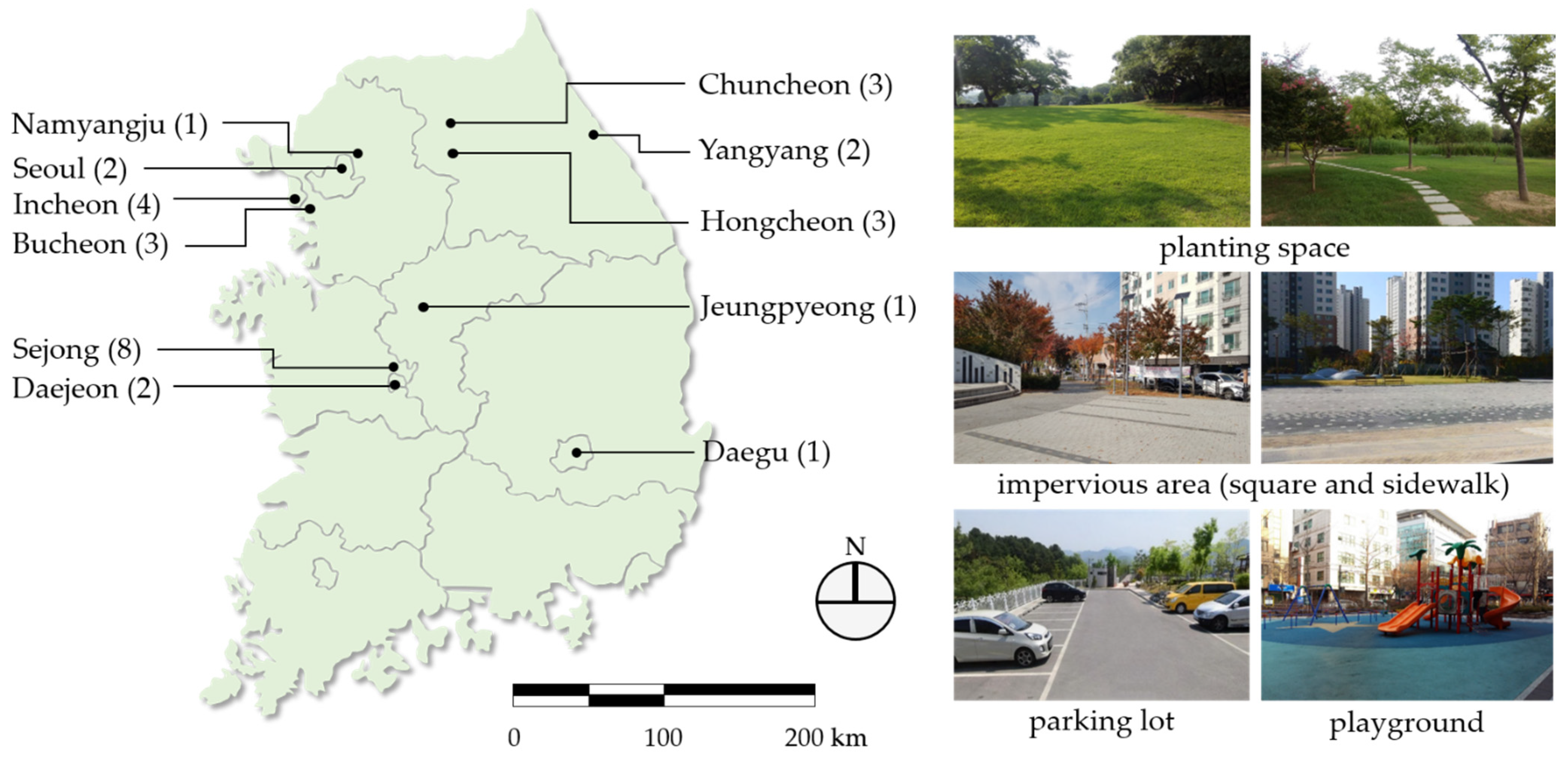
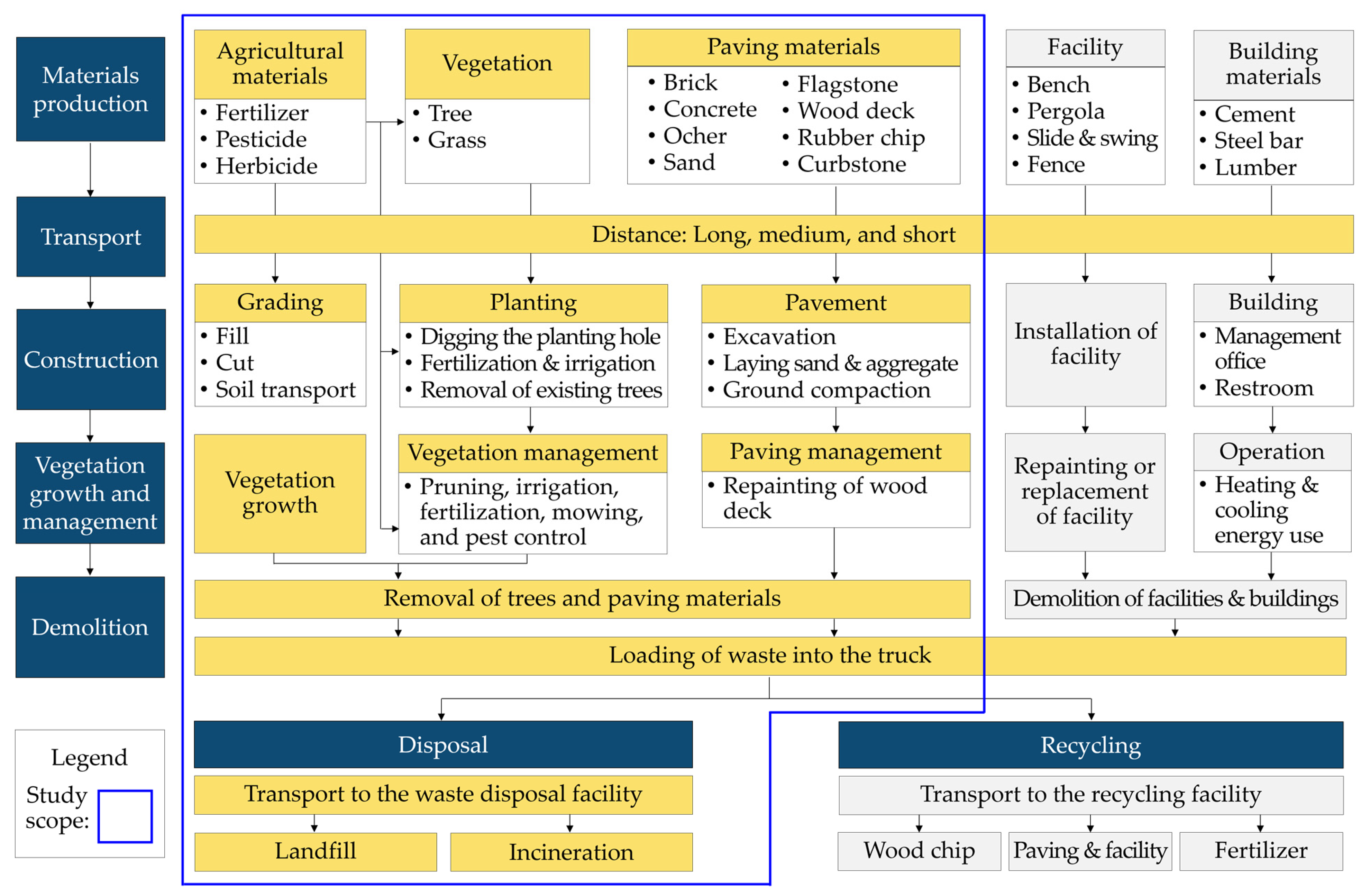


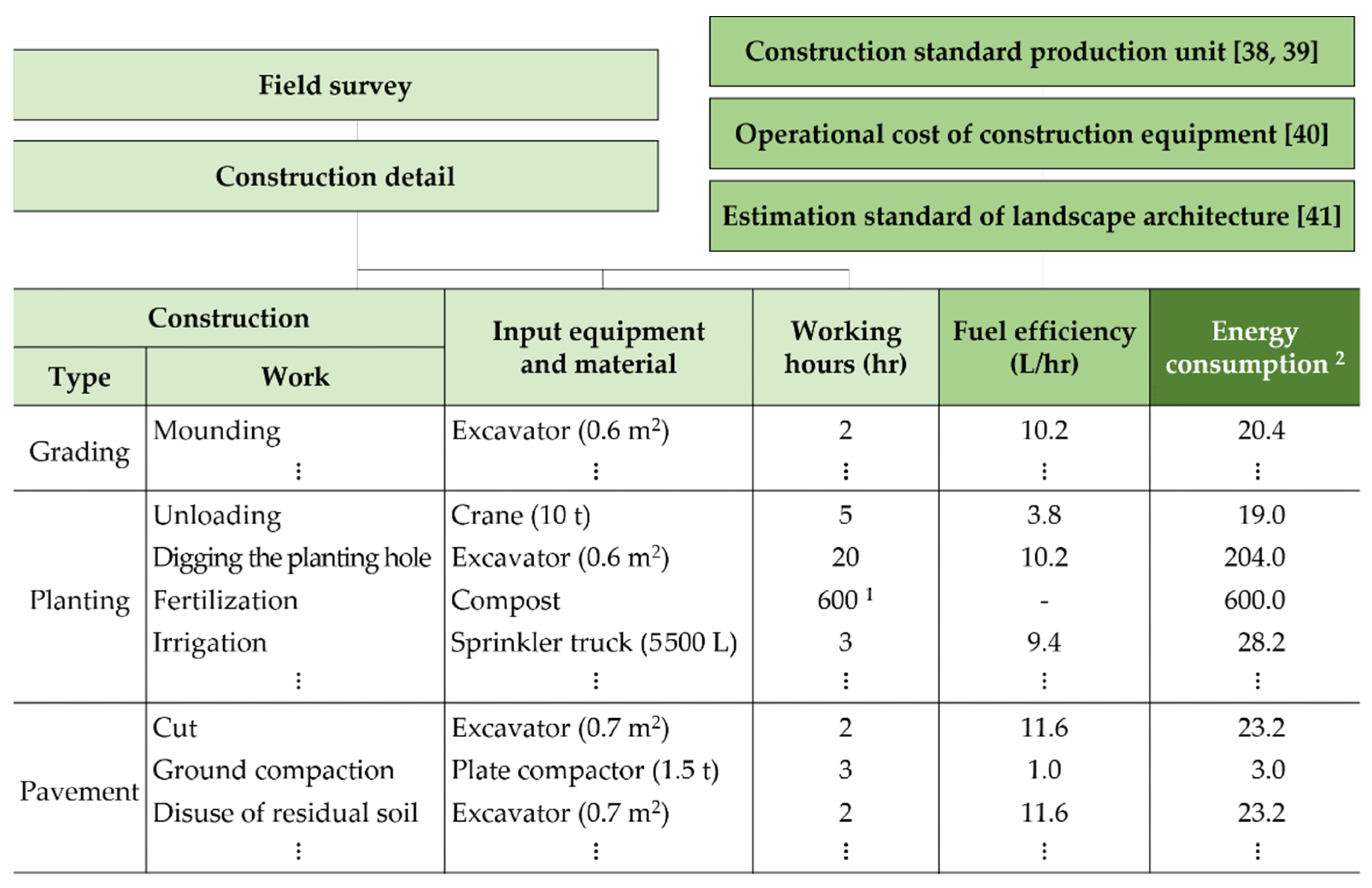
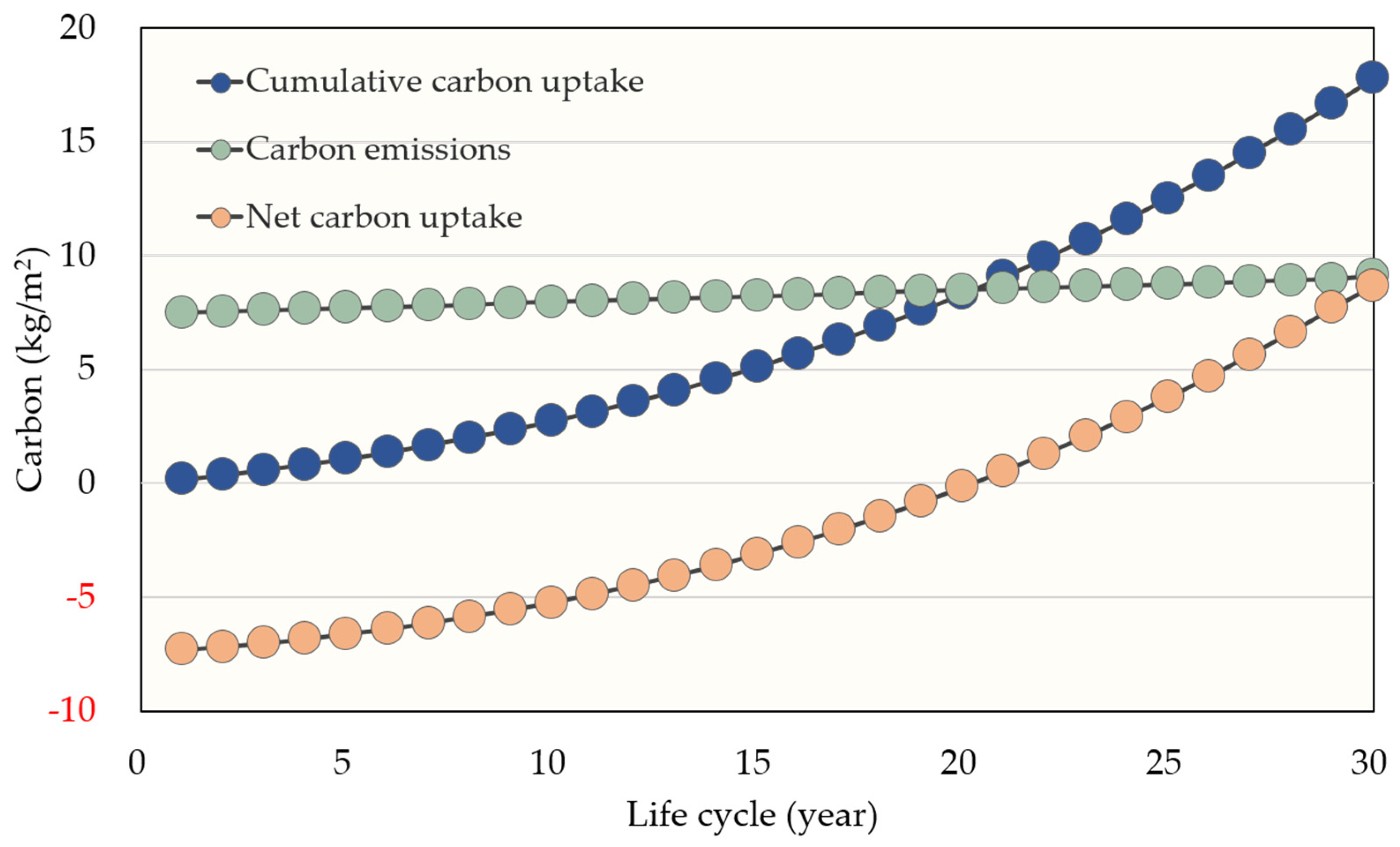
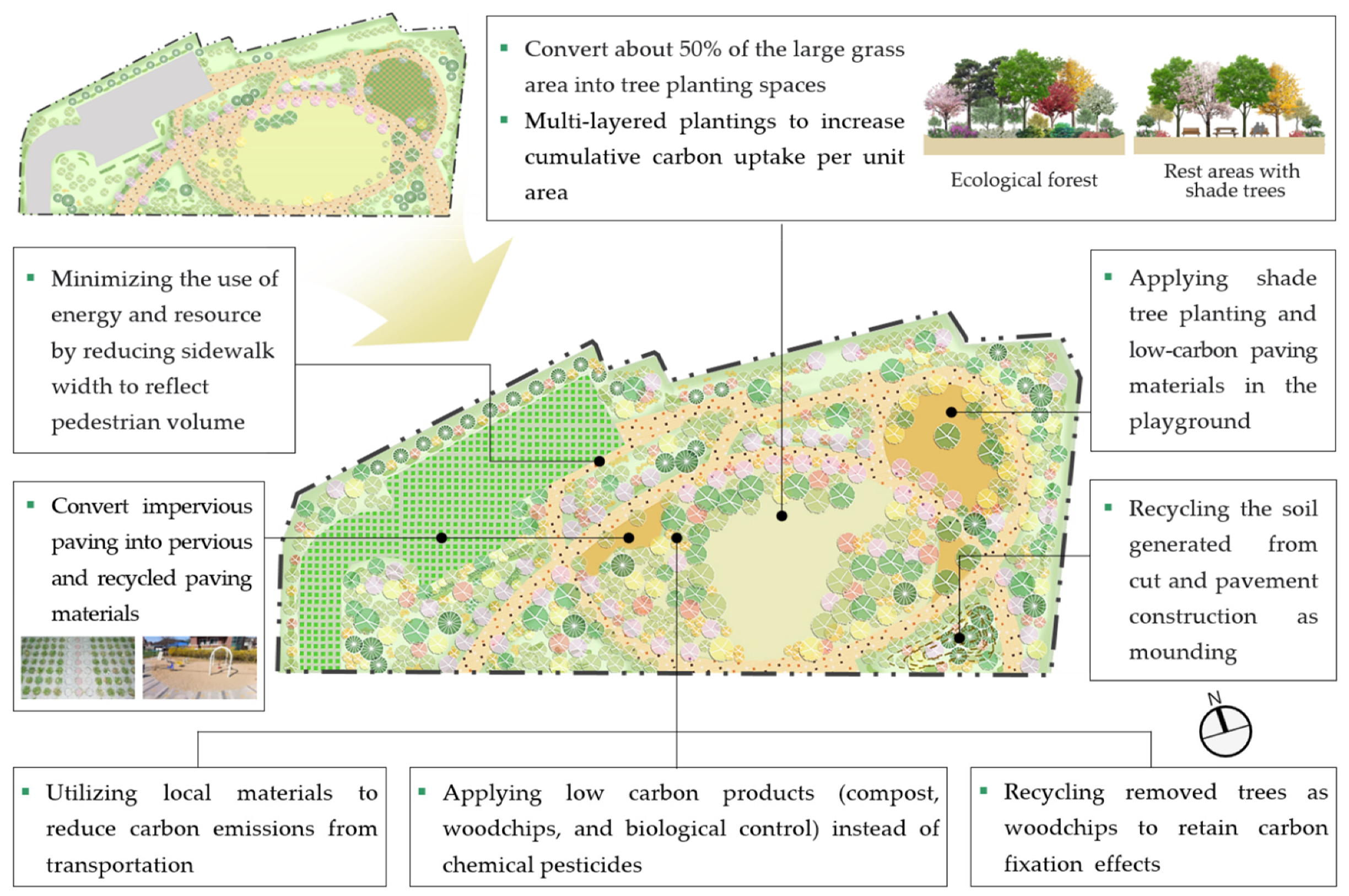
| Component | Survey Inventory | |
|---|---|---|
| Pruning | Annual frequency | |
| Annual prunning biomass (t/year) | ||
| Tool | Type (e.g., electric secateurs) | |
| Energy consumption | ||
| Disposal method of pruned branches | ||
| Irrigation | Annual frequency | |
| Amount of water per year (L/year) | ||
| Tool | Type (e.g., spinkler) | |
| Energy consumption | ||
| Fertilization | Type (e.g., compost) | |
| Annual frequency | ||
| Amount of fertilizer per year (t/year) | ||
| Tool | Type (e.g., power sprayer) | |
| Energy consumption | ||
| Mowing | Annual frequency | |
| Annual mowing biomass (kg/year) | ||
| Tool | Type (e.g., mower) | |
| Energy consumption | ||
| Pesticide | Type (e.g., fungicide) | |
| Annual frequency | ||
| Amount of pesticide per year (L/year or g/year) | ||
| Tool | Type (e.g., power sprayer) | |
| Energy consumption | ||
| Species | Diameter Range (cm) 1 | Reference | |
|---|---|---|---|
| Tree | Abies holophylla | 5–19 | Jo et al., 2014 [47] |
| Acer palmatum | 7–27 | Jo and Cho, 1998 [48] | |
| “ | 5–20 | Jo and Ahn, 2012 [49] | |
| Camellia japonica | 4–10 | Jo et al., 2019a [50] | |
| Chionanthus retusus | 3–11 | Jo et al., 2014 [47] | |
| Cornus officinalis | 3–15 | Jo et al., 2014 [47] | |
| Ginkgo biloba | 6–31 | Jo and Cho, 1998 [48] | |
| “ | 5–25 | Jo and Ahn, 2012 [49] | |
| Ilex rotunda | 3–12 | Jo et al., 2019b [51] | |
| Lagerstroemia indica | 3–14 | Jo et al., 2019a [50] | |
| Pinus densiflora | 5–29 | Jo and Ahn, 2001 [52] | |
| “ | 5–25 | Jo et al., 2013 [53] | |
| Pinus koraiensis | 5–33 | Jo and Ahn, 2001 [52] | |
| “ | 5–31 | Jo et al., 2013 [53] | |
| Prunus armeniaca | 4–14 | Jo et al., 2014 [47] | |
| Prunus yedoensis | 5–23 | Jo and Ahn, 2012 [49] | |
| Quercus myrsinaefolia | 3–17 | Jo et al., 2019a [50] | |
| Taxus cuspidata | 2–15 | Jo et al., 2014 [47] | |
| Zelkova serrata | 6–34 | Jo and Cho, 1998 [48] | |
| ” | 5–28 | Jo and Ahn, 2012 [49] | |
| General hardwoods | 3–28 | Jo, 2020 [54] | |
| General softwoods | 5–31 | Jo, 2020 [54] | |
| Shrub | Pinus spp. | 0.6–3.6 | Jo, 2002 [55] |
| Rhododendron spp. | 0.4–3.4 | Jo, 2002 [55] | |
| General hardwoods | 0.4–4.0 | Jo, 2001; 2002 [55,56] | |
| General softwoods | 0.4–4.0 | Jo, 2001; 2002 [55,56] | |
| Component | Carbon Emission Coefficients (kg/C/kg) | Reference |
|---|---|---|
| Compost | 0.058 | NAS, 2017; Lee, 2020 [59,60] |
| Fertilizer | 0.221 | Lee et al., 2018 [61] |
| Fungicide | 3.38 | Pitt, 1984; Lal, 2004 [62,63] |
| Herbicide | 5.29 | NAS, 2017; Lee, 2020 [59,60] |
| Irrigation | 0.024 | Pitt, 1984 [62] |
| Oil stain | 3.06 | Lee and Yang, 2009 [64] |
| Pesticide | 3.79 | Pitt, 1984; Lal, 2004 [62,63] |
| Study Parks | Area (m2) | Land Cover Types (%) | |||||||||
|---|---|---|---|---|---|---|---|---|---|---|---|
| Tree | Grass | Paving | Etc. 1 | ||||||||
| Brick | Concrete | Ocher and Sand | Rubber Chip | Flag Stone | Wood Deck | Curbstone | |||||
| 1 | 1315 | 26.1 | - | 71.3 | - | - | - | 1.9 | - | 0.7 | - |
| 2 | 1003 | 41.1 | 7.9 | 23.7 | - | 25.3 | - | 0.3 | - | 1.7 | - |
| 3 | 1996 | 26.7 | 25.4 | 31.3 | - | 14.6 | - | - | - | 1.0 | 1.0 |
| 4 | 1006 | 16.5 | 30.7 | 33.1 | 13.7 | - | - | 3.1 | - | 2.9 | - |
| 5 | 22,546 | 23.5 | 47.4 | 7.4 | 0.1 | 15.9 | - | 3.6 | 1.2 | 0.9 | - |
| 6 | 18,681 | 30.1 | 44.3 | 19.2 | - | 3.7 | 0.7 | - | 0.2 | 0.2 | 1.6 |
| 7 | 1054 | 18.2 | 30.1 | 48.8 | - | - | - | - | - | 2.9 | - |
| 8 | 1897 | 21.5 | 23.6 | 26.6 | 18.0 | 1.0 | 8.0 | - | - | 1.3 | - |
| 9 | 1531 | 31.7 | 50.4 | 9.2 | - | 8.5 | - | - | - | 0.2 | - |
| 10 | 3789 | 11.2 | 53.0 | 20.9 | - | 7.9 | 3.5 | 0.8 | - | 2.7 | - |
| 11 | 3460 | 9.2 | 52.0 | 21.3 | 3.0 | 12.8 | - | - | - | 1.7 | - |
| 12 | 1897 | 30.0 | 30.6 | 22.3 | 1.7 | 8.1 | 1.2 | 5.3 | - | 0.8 | - |
| 13 | 49,251 | 5.7 | 10.6 | 67.6 | 10.3 | - | 2.5 | 1.2 | - | 2.1 | - |
| 14 | 17,653 | 28.5 | 34.6 | 32.1 | - | 1.5 | 0.4 | 1.6 | - | 1.3 | - |
| 15 | 23,365 | 10.1 | 59.5 | 24.7 | - | 2.3 | 2.0 | 0.4 | - | 1.0 | - |
| 16 | 21,776 | 8.0 | 60.2 | 26.8 | - | 2.3 | 0.4 | 1.3 | - | 1.0 | - |
| 17 | 27,171 | 8.2 | 64.5 | 20.5 | - | 3.2 | 0.2 | 2.1 | - | 1.1 | 0.2 |
| 18 | 14,625 | 8.8 | 57.8 | 30.4 | - | 2.2 | - | - | - | 0.8 | - |
| 19 | 10,482 | 8.6 | 66.8 | 17.0 | 1.1 | 2.2 | - | 3.8 | - | 0.5 | - |
| 20 | 17,846 | 10.3 | 56.9 | 27.0 | - | 2.8 | 2.0 | - | - | 1.0 | - |
| 21 | 18,513 | 9.0 | 54.9 | 32.7 | - | 2.4 | - | - | - | 1.0 | - |
| 22 | 2354 | 48.7 | 18.3 | 9.5 | - | 14.8 | - | 1.1 | - | 1.0 | 6.6 |
| 23 | 1006 | 33.6 | 42.5 | - | - | 13.3 | - | 4.4 | - | 1.2 | 5.0 |
| 24 | 1887 | 23.3 | 16.8 | 2.2 | 23.8 | 7.2 | - | 0.4 | 3.9 | 1.9 | 20.5 |
| 25 | 1000 | 21.3 | 28.2 | 17.3 | - | 12.2 | - | 6.2 | - | 3.0 | 11.8 |
| 26 | 14,111 | 20.1 | 43.6 | 6.5 | 6.3 | 3.7 | - | 0.1 | - | 0.3 | 19.4 |
| 27 | 4300 | 20.1 | 35.0 | 21.0 | 13.6 | - | 5.0 | 1.4 | - | 2.6 | 1.3 |
| 28 | 2793 | 15.7 | 31.0 | 48.2 | - | - | - | 3.3 | - | 1.8 | - |
| 29 | 3101 | 15.8 | 71.6 | - | - | 12.6 | - | - | - | - | - |
| 30 | 37,951 | 6.8 | 70.5 | 16.3 | 1.7 | 1.1 | - | 2.4 | - | 1.1 | 0.1 |
| Mean | 19.6 ± 2.0 | 40.6 ± 3.5 | 24.5 ± 3.1 | 3.1 ± 1.0 | 6.0 ± 1.2 | 0.9 ± 0.3 | 1.5 ± 0.3 | 0.2 ± 0.1 | 1.3 ± 0.2 | 2.3 ± 1.0 | |
| Vegetation | Paving | ||
|---|---|---|---|
| Tree | Grass | Total | |
| 0.94 ± 0.14 | 1.67 ± 0.15 | 2.61 ± 0.14 | 3.30 ± 0.36 |
| Brick | Concrete | Flagstone (Granite) | Ocher | Wood Deck | Curbstone (15 × 15 × 100 cm) 1 |
|---|---|---|---|---|---|
| 10.2 | 14.6 | 0.9 | 0.6 | 0.9 | 2.2 |
| Construction Types | ||
|---|---|---|
| Planting | Grading | Pavement |
| 0.89 ± 0.04 | 0.71 ± 0.12 | 0.27 ± 0.02 |
| Life Cycle (Year) | |||
|---|---|---|---|
| After Planting | 10 | 20 | 30 |
| 0.16 ± 0.02 | 2.54 ± 0.28 | 7.95 ± 0.86 | 17.23 ± 1.88 |
| Mowing | Irrigation | Fertilization | Pest Control | Total | |
|---|---|---|---|---|---|
| Mower | Amount of Mown Grass | ||||
| 131.4 ± 11.5 | 1414.7 ± 123.2 | 72.8 ± 8.3 | 54.8 ± 5.2 | 3.8 ± 0.4 | 1677.5 ± 131.5 |
| Paving Material | Tree | Grand Total | ||||
|---|---|---|---|---|---|---|
| Removal | Landfill | Total | Logging | Incineration | Total | |
| 0.05 ± 0.01 | 0.06 ± 0.01 | 0.11 ± 0.02 | 0.04 ± 0.00 | 0.13 ± 0.01 | 0.17 ± 0.02 | 0.28 ± 0.03 |
| Study Parks | Carbon Uptake | Carbon Emissions | Net Carbon Uptake | |||||||||
|---|---|---|---|---|---|---|---|---|---|---|---|---|
| Tree | Grass | Production | Trans Port 1 | Construction | Management | Demolition and Disposal | ||||||
| Tree | Grass | Paving | Planting | Grading | Paving | |||||||
| 1 | 16.19 | - | 2.38 | - | 7.39 | 1.08 | 0.39 | 1.018 | 0.069 | 0.18 | 0.47 | 3.21 |
| 2 | 31.81 | 0.11 | 3.34 | 0.32 | 2.81 | 0.97 | 0.41 | 0.034 | 0.125 | 0.56 | 0.94 | 22.41 |
| 3 | 9.90 | 0.36 | 0.51 | 1.04 | 3.41 | 0.73 | 0.26 | 0.046 | 0.109 | 1.04 | 0.31 | 2.81 |
| 4 | 14.85 | 0.43 | 1.67 | 1.26 | 5.23 | 0.76 | 0.49 | 0.003 | 0.132 | 1.31 | 0.28 | 4.16 |
| 5 | 12.57 | 0.67 | 0.80 | 1.94 | 1.04 | 0.47 | 0.57 | 1.325 | 0.039 | 1.92 | 0.25 | 4.88 |
| 6 | 19.33 | 0.63 | 0.95 | 1.82 | 2.09 | 0.41 | 0.55 | 0.125 | 0.063 | 1.83 | 0.24 | 11.87 |
| 7 | 48.78 | 0.42 | 2.08 | 1.23 | 5.48 | 0.86 | 0.66 | 0.181 | 0.169 | 1.49 | 0.50 | 36.56 |
| 8 | 26.87 | 0.33 | 1.23 | 0.97 | 5.57 | 0.83 | 0.42 | 0.072 | 0.119 | 1.08 | 0.38 | 16.53 |
| 9 | 30.70 | 0.71 | 1.34 | 2.06 | 1.02 | 0.40 | 0.52 | 0.142 | 0.045 | 2.14 | 0.34 | 23.40 |
| 10 | 20.61 | 0.75 | 0.86 | 2.17 | 2.93 | 0.59 | 0.66 | 0.700 | 0.150 | 2.14 | 0.28 | 10.87 |
| 11 | 19.26 | 0.73 | 0.45 | 2.13 | 3.02 | 0.64 | 0.60 | 0.601 | 0.145 | 2.08 | 0.23 | 10.10 |
| 12 | 38.79 | 0.43 | 2.08 | 1.25 | 3.56 | 0.72 | 0.60 | 0.084 | 0.163 | 1.40 | 0.29 | 29.07 |
| 13 | 4.90 | 0.15 | 0.43 | 0.44 | 8.70 | 1.18 | 0.18 | 0.098 | 0.289 | 0.45 | 0.12 | −6.83 |
| 14 | 13.42 | 0.49 | 0.28 | 1.42 | 3.54 | 0.51 | 0.41 | 0.004 | 0.104 | 1.40 | 0.13 | 6.11 |
| 15 | 18.33 | 0.84 | 0.35 | 2.44 | 2.91 | 0.47 | 0.63 | 0.007 | 0.096 | 2.38 | 0.18 | 9.71 |
| 16 | 16.40 | 0.85 | 0.37 | 2.47 | 3.01 | 0.48 | 0.65 | 0.005 | 0.098 | 2.40 | 0.17 | 7.60 |
| 17 | 16.98 | 0.91 | 0.38 | 2.65 | 2.37 | 0.42 | 0.66 | 0.005 | 0.086 | 2.56 | 0.17 | 8.59 |
| 18 | 15.33 | 0.82 | 0.41 | 2.37 | 3.32 | 0.51 | 0.67 | 0.004 | 0.107 | 2.31 | 0.18 | 6.27 |
| 19 | 19.47 | 0.94 | 0.31 | 2.74 | 2.15 | 0.38 | 0.71 | 0.005 | 0.072 | 2.66 | 0.17 | 11.21 |
| 20 | 18.59 | 0.80 | 0.55 | 2.33 | 3.20 | 0.51 | 0.63 | 0.005 | 0.098 | 2.29 | 0.21 | 9.58 |
| 21 | 17.27 | 0.78 | 0.47 | 2.25 | 3.58 | 0.54 | 0.62 | 0.005 | 0.107 | 2.20 | 0.20 | 8.06 |
| 22 | 8.29 | 0.26 | 0.90 | 0.75 | 1.21 | 0.47 | 0.31 | 0.115 | 0.072 | 0.86 | 0.27 | 3.58 |
| 23 | 24.55 | 0.60 | 1.41 | 1.74 | 0.28 | 0.43 | 0.69 | 0.208 | 0.049 | 1.80 | 0.37 | 18.17 |
| 24 | 12.43 | 0.24 | 0.91 | 0.69 | 4.88 | 0.90 | 0.32 | 0.015 | 0.099 | 0.79 | 0.26 | 3.79 |
| 25 | 7.27 | 0.40 | 0.86 | 1.16 | 2.32 | 0.56 | 0.33 | 0.017 | 0.048 | 1.15 | 0.37 | 0.86 |
| 26 | 7.20 | 0.62 | 0.30 | 1.79 | 1.64 | 0.32 | 0.43 | 0.040 | 0.041 | 1.72 | 0.12 | 1.40 |
| 27 | 13.43 | 0.49 | 0.45 | 1.43 | 5.05 | 0.72 | 0.45 | 0.262 | 0.220 | 1.43 | 0.28 | 3.62 |
| 28 | 5.23 | 0.44 | 0.51 | 1.27 | 5.26 | 0.71 | 0.32 | 0.213 | 0.054 | 1.23 | 0.17 | −4.06 |
| 29 | 3.48 | 1.01 | 1.29 | 2.94 | 0.08 | 0.33 | 0.92 | 0.051 | 0.003 | 2.82 | 0.27 | −4.21 |
| 30 | 4.68 | 1.00 | 0.33 | 2.89 | 2.08 | 0.34 | 0.57 | 0.678 | 0.076 | 2.73 | 0.15 | −4.17 |
| Mean | 17.23 ± 1.88 | 0.57 ± 0.05 | 0.94 ± 0.14 | 1.67 ± 0.15 | 3.30 ± 0.36 | 0.61 ± 0.04 | 0.52 ± 0.03 | 0.202 ± 0.060 | 0.102 ± 0.011 | 1.68 ± 0.13 | 0.28 ± 0.03 | 8.51 ± 1.80 |
Publisher’s Note: MDPI stays neutral with regard to jurisdictional claims in published maps and institutional affiliations. |
© 2021 by the authors. Licensee MDPI, Basel, Switzerland. This article is an open access article distributed under the terms and conditions of the Creative Commons Attribution (CC BY) license (https://creativecommons.org/licenses/by/4.0/).
Share and Cite
Park, H.-M.; Jo, H.-K. Ecological Design and Construction Strategies through Life Cycle Assessment of Carbon Budget for Urban Parks in Korea. Forests 2021, 12, 1399. https://doi.org/10.3390/f12101399
Park H-M, Jo H-K. Ecological Design and Construction Strategies through Life Cycle Assessment of Carbon Budget for Urban Parks in Korea. Forests. 2021; 12(10):1399. https://doi.org/10.3390/f12101399
Chicago/Turabian StylePark, Hye-Mi, and Hyun-Kil Jo. 2021. "Ecological Design and Construction Strategies through Life Cycle Assessment of Carbon Budget for Urban Parks in Korea" Forests 12, no. 10: 1399. https://doi.org/10.3390/f12101399
APA StylePark, H.-M., & Jo, H.-K. (2021). Ecological Design and Construction Strategies through Life Cycle Assessment of Carbon Budget for Urban Parks in Korea. Forests, 12(10), 1399. https://doi.org/10.3390/f12101399







